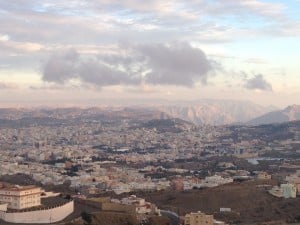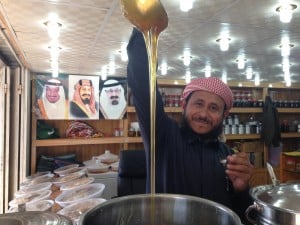Blog Archive
A Study in Contradictions: A Tenement Museum Employee Visits Saudi Arabia
How do you imagine Saudi Arabia? Desert? Camels? Oil? Oppressed women? That was what I pictured. Traveling to Saudi felt more foreign than anywhere I have ever been. What would I need? Would I lose my identity and independence when the black abaya covered my body? Would its flowing fabric render me invisible or transform me into a wizard out of Harry Potter? With so many questions and so much to learn, I talked to many people in an effort to ensure that I would be respectful and stay safe. In truth, it was difficult to uncover much information. Some people warned me not to go out of fear of the unknown, while others were thrilled by the opportunity for cultural exchange that attending the National Built Heritage Forum in Abha offered.
Upon arrival the debunking of my assumptions began with the location of the forum itself. There is no desert in Abha – or camels for that matter. Located in the Asir region of the country, Abha is mountainous and cool. While I had pictured a singular image of Saudi, I discovered diversity, intelligent women, and lots of color. I struggled to reconcile hearing a veiled woman confidently and articulately share her scholarship and expertise with a separate seated audience. These contradictions to my established Saudi narrative kept pushing through the surface, bringing new puzzles and questions with them.
There was the inherent contradiction of attending a forum dedicated to the investment of built heritage and tourism in a country that does not distribute tourist visas. There were distinctions between heritage sites and museums that I was unaccustomed to and differing ideas regarding the authenticity of place and when it moves from real to echo of Disneyland that left me unsettled. Saudis also seem to place more value on the new and modern, a fundamental difference to my own way of thinking which gives preference to preserving the old prior to rebuilding it anew.
Fashion also sparked much contemplation. How is it possible for a woman to look fabulous in the shapeless cloak of the abaya? Similarly, abaya style and the choice of veil, embroidered colors versus austere black, and pairings with designer handbags and heels or Uggs all made me wonder what the abaya actually communicated about religion, ideas of gender, and personal style. In addition to my fascination with women’s clothing, I experienced shock at the discovery that I rather liked the look of men in dresses and couldn’t stop thinking about when and how pants became the official menswear of most of the world.
My short time in Saudi taught me some important things. Saudi Arabian heritage is rich and varied like the tribes its people descend from. Contrary to popular media depiction Saudi Arabia is distinct from The Middle East. The country’s name and history no longer blends into the borders of Yemen and Iraq as it did before my arrival although my knowledge remains filled with gaps.
Issues of women’s rights are also not as black and white as I assumed. I met Saudi women leading university departments, working for ministries, and running companies. And while I was quite happy to put my abaya away, I no longer see it exclusively as a garment of oppression although I do believe women should have the right to choose to wear it, much as they should have the right to be able to choose to drive.
These debates are a study in contradictions that challenged my notions of feminism, preservation, and even royalty, ultimately raising more questions than they answered. Perhaps that is the sign of a successful journey.
– Miriam Bader, Director of Education at The Lower East Side Tenement Museum

